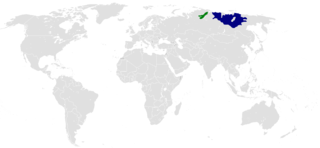
Back Dolğan dili Azerbaijani دولقان تورکجهسی AZB Далганская мова BE-X-OLD Долгански език Bulgarian Dolganeg Breton Dolgan Catalan Dolgan-ngṳ̄ CDO Долганийн мотт CE Долган чĕлхи CV Dolganische Sprache German
This article should specify the language of its non-English content, using {{lang}}, {{transliteration}} for transliterated languages, and {{IPA}} for phonetic transcriptions, with an appropriate ISO 639 code. Wikipedia's multilingual support templates may also be used - notably dlg for Dolgan. (October 2024) |
| Dolgan | |
|---|---|
| Дулҕан тыла,Dulğan tyla Һака тыла, Haka tyla | |
| Pronunciation | [dɔlgæn] |
| Native to | Russia |
| Region | Taymyrsky Dolgano-Nenetsky District, Krasnoyarsk Krai |
| Ethnicity | Dolgans |
Native speakers | 5,300 (2020 census)[1] |
Turkic
| |
| Dialects |
|
| Language codes | |
| ISO 639-3 | dlg |
| Glottolog | dolg1241 |
| ELP | Dolgan |
 Yakut Language (blue) and Dolgan Language (green) | |
 Dolgan is classified as Definitely Endangered by the UNESCO Atlas of the World's Languages in Danger | |
The Dolgan language is a severely endangered Turkic language with 930 speakers,[2] spoken in the Taymyr Peninsula in Russia.[3] The speakers are known as the Dolgans. The word "Dolgan", derived from Evenki, means 'tribe living on the middle reaches of the river'. This is most likely signifying the geographical location of the Dolgan tribe.[4] Its closest relative is Sakha.
The language is very local and restricted to a certain area and has declined in usage over the years. As of 2020 there are only about 5,350 speakers of the language.[1] The language has experienced a few changes since the beginning of its formation, such as alphabet and phrasing terms. The issue as of recently has become the weak integration of this local language within families with mixed marriages. Instead of speaking either of the parents' local languages, the family incorporates Russian as the more dominant language to ease interfamilial and external communication.[5] This results in children learning the language only slightly or as a second language. Over generations, the language continues to fade. In 1999, however, some children were apparently learning Dolgan, with Russian also being learned at an early age.[6]
- ^ a b 7. НАСЕЛЕНИЕ НАИБОЛЕЕ МНОГОЧИСЛЕННЫХ НАЦИОНАЛЬНОСТЕЙ ПО РОДНОМУ ЯЗЫКУ
- ^ Pakendorf, Brigitte; Stapert, Eugénie (2020). "Sakha and Dolgan, the North Siberian Turkic languages". The Oxford Guide to the Transeurasian Languages. Oxford University Press. pp. 430–445. doi:10.1093/oso/9780198804628.003.0027. ISBN 978-0-19-880462-8.
- ^ Cite error: The named reference
:0was invoked but never defined (see the help page). - ^ "Dolgan language, pronunciation and language". www.omniglot.com. Retrieved 6 March 2017.
- ^ Lewis, E. Glyn (1971). "Migration and Language in the U.S.S.R." (PDF). The International Migration Review. 5 (2): 147–179. doi:10.2307/3002797. JSTOR 3002797.
- ^ "Endangered languages in Northeast Asia: report". University of Helsinki. 11 February 2019. Archived from the original on 11 February 2019. Retrieved 31 July 2024.